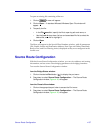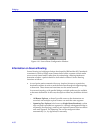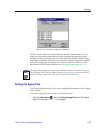
Bridging
4-60 Source Route Configuration
Subnet Mask
A subnet mask is used by a device to determine whether a destination address
exists within its own subnetwork (logical division of the network by router or
gateway) and can be reached directly, or whether it is unknown and therefore
must be delivered to a router (as speciÞed by the deviceÕs IP routing table or
default gateway address).
A subnet mask should be set at the device if it will issue SNMP traps in a routed
environment, so that the trap messages it generates will be routed correctly.
A subnet mask acts as a Þlter for destination IP addresses. It is a 32-bit quantity in
which all bits that correspond to the network portion (both site and subnet
identifying bits) of the deviceÕs IP address are set to 1, and all bits that correspond
to the host portion are set to 0.
The device will logically AND a destination trap IP address with the subnet mask
to determine which portion of the address identiÞes the network/subnetwork.
The device then compares the result on a bit-to-bit basis with the network
identifying bits in its own IP address. If the network portions match, the bridging
device transmits the trap onto its subnetwork. If they do not match, the device
transmits the trap through a router or gateway.
This Þeld can only be edited (with the correct security access) via Local
Management for the device (or the MIBTools utility). Refer to the appropriate
device-speciÞc UserÕs Guide for more information.
MAC Address
This Þeld displays the Media Access Control (MAC) layer address which
identiÞes the ports/interfaces of the bridging device on a network. This six-byte
address is set at the factory and is unique to each interface. Each byte is identiÞed
in bit order starting with the most signiÞcant bit. You cannot conÞgure this Þeld.
The following Þelds apply to the Source Route ConÞguration window:
Local Segment
This Þeld displays the unique segment number that identiÞes the segment
attached to the selected interface (either of the Token Ring or FDDI interfaces).
The bridge adds the Local Segment number to the routing information Þeld of
source route discovery frames. Valid values range from 0 to 4095.
Target Segment
This Þeld displays the unique segment number of the target segment that the
source routed frame will be forwarded to. Valid values range from 0 to 4095.
Hop Count Limit
The maximum number of routing descriptors (i.e., bridge hops) allowed for an All
Routes Explorer or a Spanning Tree Explorer frame received by the device. This
will reduce the unnecessary propagation of explorer frames through the network.


















